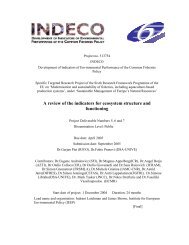WP5 Case study on genetic resources in food and agriculture
WP5 Case study on genetic resources in food and agriculture
WP5 Case study on genetic resources in food and agriculture
You also want an ePaper? Increase the reach of your titles
YUMPU automatically turns print PDFs into web optimized ePapers that Google loves.
As a focus of the MEACAP project is <strong>on</strong> l<strong>and</strong> use, <strong>on</strong>-farm c<strong>on</strong>servati<strong>on</strong> <strong>and</strong> thec<strong>on</strong>necti<strong>on</strong> to l<strong>and</strong>scape management <strong>and</strong> nature c<strong>on</strong>servati<strong>on</strong> is especially <strong>in</strong>terest<strong>in</strong>g.An evaluati<strong>on</strong> of AEMs under Reg. (EC) No.2078/99 underl<strong>in</strong>ed, that support of rarebreeds could <strong>in</strong>duce farmers to stay <strong>in</strong> marg<strong>in</strong>al rural areas (Fadlaoui et al. 2005). On theother h<strong>and</strong>, ab<strong>and</strong><strong>on</strong>ment of marg<strong>in</strong>al farml<strong>and</strong>, where more often traditi<strong>on</strong>al breeds <strong>and</strong>crops are still be<strong>in</strong>g used, as the Polish example shows, could lead to rare breeds notbe<strong>in</strong>g utilised any more.• Wild relatives of crops can be preserved <strong>in</strong> natural surround<strong>in</strong>gs, <strong>and</strong> can thusprofit from measures directed at the c<strong>on</strong>servati<strong>on</strong> of general biodiversity e.g.with<strong>in</strong> Natura 2000 areas, species rich grassl<strong>and</strong> <strong>and</strong> other nature c<strong>on</strong>servati<strong>on</strong>measures. Here, as well the design of cross-compliance requirements c<strong>on</strong>cern<strong>in</strong>gthe c<strong>on</strong>servati<strong>on</strong> of permanent pasture play a role. These synergies should bec<strong>on</strong>sidered.• Traditi<strong>on</strong>al livestock breeds are often associated with high-nature value farml<strong>and</strong>(EEA, 2006), <strong>and</strong> l<strong>and</strong>scape c<strong>on</strong>servati<strong>on</strong> measures can be dependent <strong>on</strong> hardybreeds (traditi<strong>on</strong>al breeds are often smaller than ma<strong>in</strong>stream breeds <strong>and</strong> their feetdo less damage to the ground; they can cope with the local climate <strong>and</strong> cansometimes digest poorer plants). This c<strong>on</strong>necti<strong>on</strong> should be taken <strong>in</strong>to accountwhen design<strong>in</strong>g support measures (e.g. the Dutch nati<strong>on</strong>al scheme has alreadyencouraged c<strong>on</strong>servati<strong>on</strong> organisati<strong>on</strong>s to use rare breeds for graz<strong>in</strong>g <strong>in</strong> naturereserves (Oreade-Breche, 2005); <strong>in</strong> Engl<strong>and</strong> <strong>and</strong> Wales the use of eligibletraditi<strong>on</strong>al breeds <strong>in</strong> envir<strong>on</strong>mental l<strong>and</strong> management projects <strong>in</strong> certa<strong>in</strong> areasqualifies for extra support; the EC (2005b) found very positive impacts of AEMssupport<strong>in</strong>g rare livestock breeds l<strong>in</strong>ked to transhumance). M<strong>in</strong>imum ma<strong>in</strong>tenancerequirements for n<strong>on</strong>-cultivated l<strong>and</strong> through cross-compliance might enhancethe need for such animals <strong>in</strong> areas that are not suitable for mow<strong>in</strong>g.• Organic farm<strong>in</strong>g relies <strong>on</strong> crop varieties <strong>and</strong> livestock breeds that can cope withless <strong>in</strong>tensive management. Support of organic farm<strong>in</strong>g can <strong>in</strong>crease <strong>in</strong>terest <strong>in</strong>such breeds <strong>and</strong> plant varieties).Provid<strong>in</strong>g <strong>in</strong>formati<strong>on</strong>Insufficient <strong>in</strong>formati<strong>on</strong> about availability of measures <strong>and</strong> technical implementati<strong>on</strong>has apparently been hamper<strong>in</strong>g the uptake of AEMs (e.g. <strong>in</strong> some Italian regi<strong>on</strong>s, seeOreade-Breche, 2005). The process<strong>in</strong>g <strong>and</strong> use of products stemm<strong>in</strong>g from crops <strong>and</strong>livestock <strong>genetic</strong> <strong>resources</strong> is dependent <strong>on</strong> knowledge about them. It is crucial to<strong>in</strong>crease awareness of c<strong>on</strong>sumers; farmers <strong>and</strong> processors of products about the existence<strong>and</strong> the use <strong>genetic</strong> <strong>resources</strong>.Increas<strong>in</strong>g the commercial value of <strong>genetic</strong> <strong>resources</strong>The importance to develop strategies <strong>on</strong> how to <strong>in</strong>crease the commercial value ofregi<strong>on</strong>al products c<strong>on</strong>nected to rare breeds of plant varieties is menti<strong>on</strong>ed by manysources (BMVEL, 2005; Oreade-Breche, 2005; Reg.(EC) No.870/2004; Signorello <strong>and</strong>Pappalardo, 2003).41




